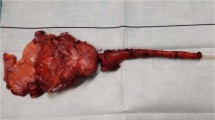Abstract
Purpose
After bladder augmentation (BA) using bowel segments, it is known that there is a risk for secondary malignancies. It remains unclear whether this also applies to spina bifida (SB) patients without BA. The aim of this study was to analyze the frequency of bladder cancer (BC) in SB at a single tertiary institution and assess the patients’ oncologic outcome.
Methods
Patients with SB and BC treated from January 2016 until March 2020 were included and corresponding data were collected retrospectively. Endpoints were progression-free survival (PFS) and overall survival (OS).
Results
Among 132 adult patients with SB, four with a median age of 34.5 years (IQR 31.5–36.8, range 31–37) had a BC. None of the patients had undergone BA. Most common symptoms included recurrent urinary tract infections (UTI) (75%) and hydronephrosis (75%). At the time of the diagnosis, tumors were locally advanced (≥ T3) and lymph-node positive in all cases. All patients underwent radical cystectomy with adjuvant chemotherapy in two out of four cases. Histology showed squamous cell carcinomas (SCC) or at least a squamous cell component in all patients. The median PFS was 5.9 months (IQR 5.1–124.5) and the median OS was 8.7 months (IQR 6.3–125.5).
Conclusions
SCC in SB can appear at a young age and is usually diagnosed in an advanced tumor stage with poor prognosis despite radical surgical resection. Patients with SB without BA with clinical symptoms, new onset of hematuria, and/or upper tract dilatation should receive a cystoscopy ± further imaging.
Similar content being viewed by others
Abbreviations
- BA:
-
Bladder augmentation
- BC:
-
Bladder cancer
- BMI:
-
Body Mass Index
- CIC:
-
Clean intermittent catheterization
- IQR:
-
Inter-quartile range
- MVAC:
-
Methotrexate, vinblastine, adriamycin, and cisplatin
- NBD:
-
Neurogenic bladder dysfunction
- OS:
-
Overall survival
- PFS:
-
Progression-free survival
- SB:
-
Spina bifida
- SCC:
-
Squamous cell carcinoma
- SCI:
-
Spinal cord injury
- UICC:
-
Union for International Cancer Control
- UTI:
-
Urinary tract infections
References
Ismail S et al (2018) Prevalence, management, and prognosis of bladder cancer in patients with neurogenic bladder: a systematic review. Neurourol Urodyn 37(4):1386–1395
Manunta A et al (2005) Non-transitional cell bladder carcinomas. BJU Int 95(4):497–502
Martin JW et al (2020) A California cancer registry analysis of urothelial and non-urothelial bladder cancer subtypes: epidemiology, treatment, and survival. Clin Genitourin Cancer 18(3):e330–e336
Mirkin K et al (2013) Risk of bladder cancer in patients with spina bifida: case reports and review of the literature. J Pediatr Rehabil Med 6(3):155–162
Gui-Zhong L, Li-Bo M (2017) Bladder cancer in individuals with spinal cord injuries: a meta-analysis. Spinal Cord 55(4):341–345
Pottegard A et al (2020) Urinary tract infections and risk of squamous cell carcinoma bladder cancer: a Danish nationwide case-control study. Int J Cancer 146(7):1930–1936
Cumberbatch MGK, Noon AP (2019) Epidemiology, aetiology and screening of bladder cancer. Transl Androl Urol 8(1):5–11
Austin JC, Elliott S, Cooper CS (2007) Patients with spina bifida and bladder cancer: atypical presentation, advanced stage and poor survival. J Urol 178(3 Pt 1):798–801
Stein R et al (2020) EAU/ESPU guidelines on the management of neurogenic bladder in children and adolescent part I diagnostics and conservative treatment. Neurourol Urodyn 39(1):45–57
Meléndez M, Maroto A, Illescas T, Allué M, Castro L, Carreras E, Cuxart A (2018) Bladder cancer in patients with spina bifida: observation from an adult clinic. Spinal Cord Ser Cases 4:1–4
Rove KO et al (2017) Systematic review of bladder cancer outcomes in patients with spina bifida. J Pediatr Urol 13(5):456e1–456e9
Pannek J (2002) Transitional cell carcinoma in patients with spinal cord injury: a high risk malignancy? Urology 59(2):240–244
Bothig R et al (2017) Clinical characteristics of bladder cancer in patients with spinal cord injury: the experience from a single centre. Int Urol Nephrol 49(6):983–994
Kalisvaart JF et al (2010) Bladder cancer in spinal cord injury patients. Spinal Cord 48(3):257–261
Parra J et al (2007) Bladder cancer in neurological patients: analysis of a single-centre series. Prog Urol 17(7):1333–1336
Subramonian K et al (2004) Bladder cancer in patients with spinal cord injuries. BJU Int 93(6):739–743
Böthig R, Tiburtius C, Fiebag K, Kowald B, Hirschfeld S, Thietja R et al (2020) Traumatic spinal cord injury confers bladder cancer risk to patients managed without permanent urinary catheterization: lessons from a comparison of clinical data with the national database. World J Urol. https://doi.org/10.1007/s00345-020-03077-3
Schned AR et al (2008) Histological classification and stage of newly diagnosed bladder cancer in a population-based study from the Northeastern United States. Scand J Urol Nephrol 42(3):237–242
Saginala K et al (2020) Epidemiology of bladder cancer. Med Sci (Basel). https://doi.org/10.3390/medsci8010015
Zaghloul MS (2012) Bladder cancer and schistosomiasis. J Egypt Natl Cancer Inst 24(4):151–159
Biardeau X et al (2016) Risk of malignancy after augmentation cystoplasty: a systematic review. Neurourol Urodyn 35(6):675–682
Boissier R et al (2016) What is the outcome of paediatric gastrocystoplasty when the patients reach adulthood? BJU Int 118(6):980–986
Higuchi TT et al (2010) Augmentation cystoplasty and risk of neoplasia: fact, fiction and controversy. J Urol 184(6):2492–2496
Hamid R et al (2009) Routine surveillance cystoscopy for patients with augmentation and substitution cystoplasty for benign urological conditions: is it necessary? BJU Int 104(3):392–395
Higuchi TT, Fox JA, Husmann DA (2011) Annual endoscopy and urine cytology for the surveillance of bladder tumors after enterocystoplasty for congenital bladder anomalies. J Urol 186(5):1791–1795
Author information
Authors and Affiliations
Corresponding author
Additional information
Publisher's Note
Springer Nature remains neutral with regard to jurisdictional claims in published maps and institutional affiliations.
Rights and permissions
About this article
Cite this article
Mühlbauer, J., Stein, R. & Younsi, N. Bladder cancer in patients with spina bifida: a serious risk. World J Urol 39, 1531–1537 (2021). https://doi.org/10.1007/s00345-020-03338-1
Received:
Accepted:
Published:
Issue Date:
DOI: https://doi.org/10.1007/s00345-020-03338-1




